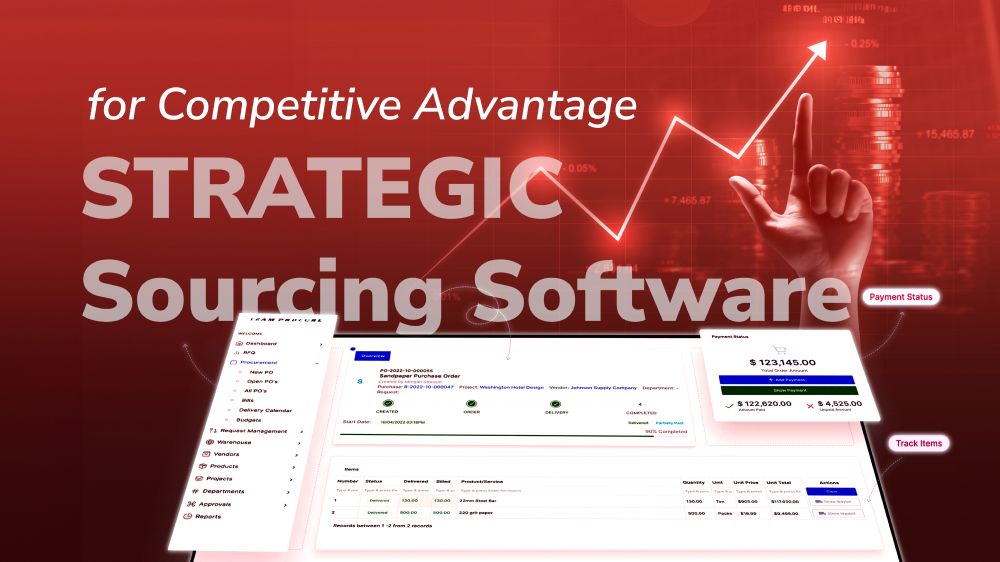
Software Development Outsourcing Trends That Shape the Industry in 2025 and Beyond
Take a glimpse into evolving trends in software development outsourcing, poised to shape the entire industry in 2025 and the years ahead.

Content Map
More chaptersSoftware outsourcing, also known as a type of business process outsourcing, is currently a strategic business approach that enables businesses to hire a third-party vendor to take care of projects or develop software on their behalf. This approach offers numerous benefits, typically considerable cost savings, faster time-to-market, and immediate access to a pool of skilled engineers. As mentioned, outsourcing software development is preferred by many organizations, especially when one company requires additional resources or expertise.
At the present time, outsourcing is no longer a global phenomenon but is becoming a new norm, particularly in the tech industry. In 2025 and the following years, the software development outsourcing sector is anticipated to continue its growth, with emerging trends that will likely impact the industry and direction. That’s what we are going to do today, sneaking a peek into the future to see what’s next.
An Overview of the Global Outsourcing Market: Statistics & Insights
Before that, let’s look at a few staggering stats to see what has dominated the IT and software development outsourcing space until now.
- According to Statista’s Technology Market Insights, the IT outsourcing industry is divided into multiple segments, including administration outsourcing, application/software development outsourcing, web hosting, and others. These segments collectively brought in more than $460 billion in revenue.
- In 2024, the total revenue of the global IT outsourcing market (including software development) was forecasted to reach a volume of $541.4 billion. Its upward trajectory will keep progressing steadily in the next years. (Source: Statista)
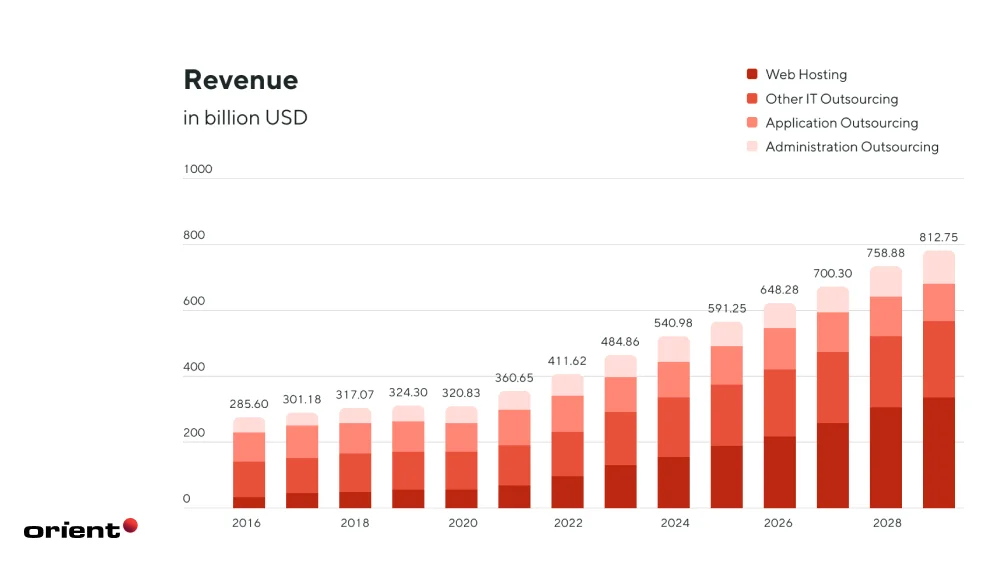
- In 2020, ITO (IT and software outsourcing) only accounted for a 22% ($159.26) share of the global market. It is predicted to reach a 25% share in 2025 (According to Krusche Co.).
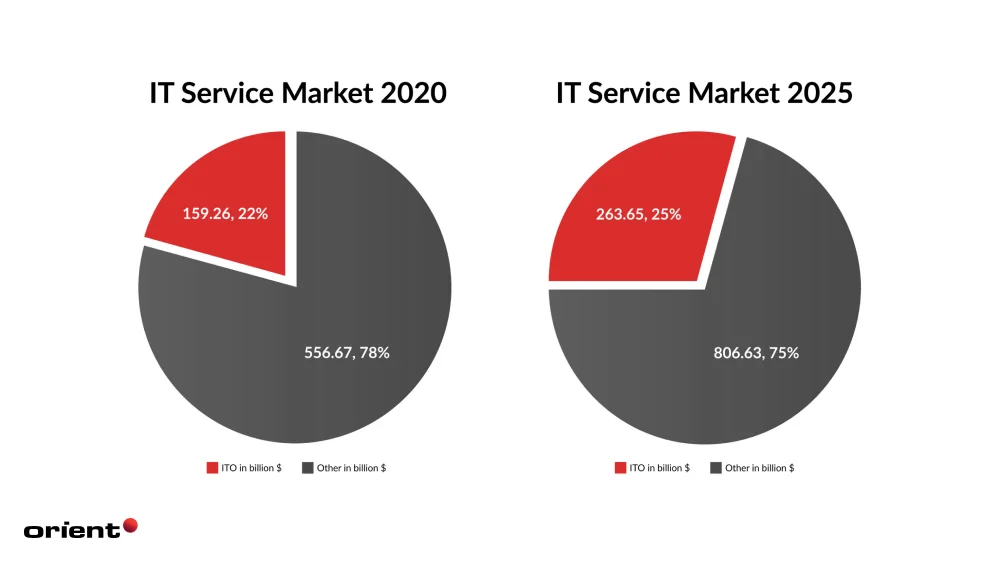
- In the period from 2023 to 2027, the revenue of software outsourcing is forecasted to thrive at a CAGR of 7.54%. (Statista)
- 40% of the CTOs share the opinion that software development outsourcing is needed. In a survey by Computer Economics, 49.6% of respondents plan to expand their outsourcing efforts, and 40% maintain the current levels.
Trend Forecasting: What Does the Future Holds for Software Development Outsourcing?
Now, it is time to dive into some predictions on the rising trends in the software outsourcing industry. Know that there will be no absolute right or wrong here. You may be surprised by some trends that may continue to flourish in the future while other new things are likely to emerge in the coming years and beyond. The key drivers behind the following software outsourcing trends are increasing technology adoption, cost reduction strategies, and market competition.
AI - and Automation-Driven Development Services
Artificial intelligence (AI) and robotic process automation (RPA) are revolutionizing the software development industry in multiple ways. They enable companies to automate routine tasks, reduce errors, and enhance productivity. For example, AI-powered tools, such as GitHub Copilot and Tabnine, aid developers in generating code snippets and recommending improvements in real time. This is a huge help as it can reduce coding time by up to 30%. RPA, in particular, allows businesses to streamline repetitive processes by employing software robots to perform tasks that typically require human intervention.

In 2024, the whole world has been crazed about AI and its diverse models and applications. Still, its real impact on the software development outsourcing sector only begins to unfold. In the upcoming time, more and more software outsourcing companies will introduce AI-driven development services to their clients, offering them opportunities to be more efficient in their partner roles and deliver projects faster.
As AI integration accelerates, there will be no doubt an increasing demand for specialized AI and machine learning expertise, which creates a big skill gap. This can be a positive sign for outsourcing companies. A survey by Deloitte indicated that 52% of respondents choose outsourcing to cope with their skill gaps in AI. Moreover, the hype for AI technologies also raises ethical concerns, but that’s the story of another day.
Rise of Hyper-Specialized Talent Pools
Speaking of skill gaps or tech talent shortages, outsourcing persists to be the workaround. The access to the global talent pool is one thing, but the soaring demand for niche skills and deep expertise is the next challenge. For example, AI, data science, blockchain, Internet of Things (IoT), cloud computing, DevOps, or cybersecurity.

Meanwhile, upskilling has also become a nerve-wracking issue for organizations, especially in the realm of tech. With hyper-specialization turning into a defining feature in the software outsourcing industry, service providers are now offering mentorships, training programs, and other upskilling initiatives as add-ons to their services and as a strategy for maintaining a competitive edge in such a crowded market like the software development outsourcing industry.
Priority Shift: Value, Talent, and Quality Over Cost
Accelerance’s guide showed that outsourcing saves up to 40% of costs. And 70% of respondents, business leaders among them, named cost-saving as the primary reason for their outsourcing endeavors, according to a Deloitte survey. It is indeed that outsourcing software development or IT needs is meant to drive down expenses while boosting productivity. It still holds true today, or at least, it remains the case for many companies.
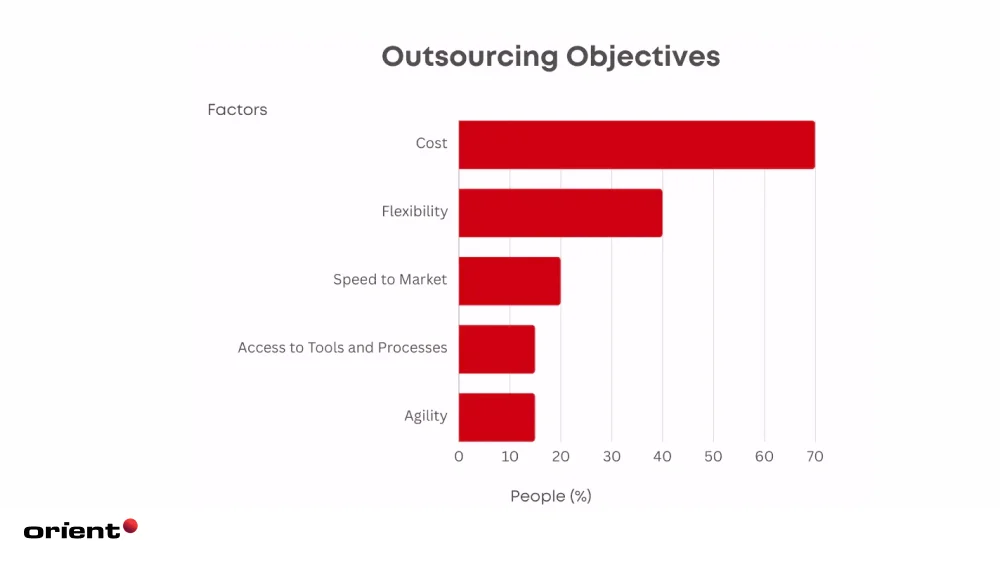
However, starting in 2025, outsourcing is not merely about cost reduction but so much more. The need for niche and in-depth industry expertise, as mentioned above, will be one of the reasons for the shift toward talent-based outsourcing. Other motives can be the increasing complexity of software development projects, the growing importance of technology to businesses across industries, and the need for companies and organizations to differentiate themselves in a crowded marketplace. Therefore, a software development outsourcing partner must be able to offer various services and capabilities beyond mere coding and staffing.
This also means value-driven approaches and innovative solutions are what business owners care more about than saving their budgets but compromising quality in return. Collaboration between companies and their outsourced partners will be essential to ensure that quality requirements are well-defined and clearly understood by all parties involved. This may include defining quality metrics and goals, establishing testing and verification procedures, and implementing quality control measures. In short, cost-saving will remain a top priority, but business owners will want more than that when they invest in outsourcing partners.
Green Initiatives and Sustainability in Software Outsourcing
In parallel with the “fever” for machine intelligence, green technology is an interesting topic that has gained public attention recently, and 2025 may be the starting point for this movement to go mainstream. This is due to the global awareness about environmental concerns. Businesses increasingly seek methods to reduce their carbon footprint and promote sustainable practices. The software development industry is no exception, and green initiatives are becoming essential in outsourcing decisions.

In the next few years, we will witness the growing focus on green initiatives and sustainability in software development outsourcing trends. Companies will seek to work with software outsourcing providers demonstrating a commitment to environmentally friendly practices. For instance, reducing energy consumption, minimizing waste, and supporting renewable energy sources. This may involve selecting partners implementing green policies and procedures in their organizations or using eco-friendly development methodologies, such as energy-efficient coding techniques.
In addition to the environmental benefits, adopting green initiatives and sustainable practices in software outsourcing can have positive business implications. Demonstrating a commitment to sustainability can help business owners improve their brand image, attract environmentally conscious clients, and meet the growing demand for eco-friendly products and services.
As discussed in a forecast by Fortune Business Insights, the global market for green tech and sustainability was valued at $17.21 billion (2023). This number is projected to sharply increase at a CAGR of 22.4%, from USD $20.90 billion in 2024 to $105.26 billion by 2032. So, we can be optimistic about a future wherein green technology becomes a norm in software development outsourcing.
Onshoring and Nearshoring to Regional Hubs
Offshore outsourcing will prevail as the top outsourcing strategy for those looking for lower costs and global access to talent. But there may be a shift in the focus on regional hubs, rather than individual countries, for outsourcing destinations. In 2025, nearshore and onshore outsourcing will rise again due to several practical factors, such as cultural alignment and proximity in collaboration.

The following tech hubs are expected to gain traction in the near future:
- Mexico: The IT services market in Mexico is projected to reach $35,261.1 million by 2030. (Source: Grand View Research)
- Brazil: The revenue of Brazil’s IT services is projected to reach $29.84 by 2029. (Source: Statista)
- Poland: By 2029, the Poland ICT market size is forecasted to reach $46.51 billion. (Source: Mordor Intelligence)
Countries like Mexico and Brazil may be the top choices for U.S. companies, while Poland may be the chosen destination for European businesses. These are just some examples of regional hubs with growing potential, but the accurate answer to which region will lead the outsourcing market in 2025 remains unknown. Stay tuned.
Embracing Low-code/No-code Development Platforms
Low-code and no-code platforms democratize software development. In brief, these platforms enable users to create software applications with minimal or no hand-coding. Low-code or no-code development is not new, but it started to gain a lot of attention in recent years. These platforms offer a suite of visual interfaces, templates, and drag-and-drop tools to help non-technical users build applications with less stress.
This year may be the high time for no-code/low-code development platforms to be in great demand and revolutionize the software development outsourcing industry. And perhaps it is the way of the future. According to Gartner, 70% of new applications will be developed using low-code or no-code technologies by 2025. No-code/low-code platforms enable outsourcing service providers to develop and deploy solutions faster. This can result in faster time to market, increased agility, and cost savings for businesses.
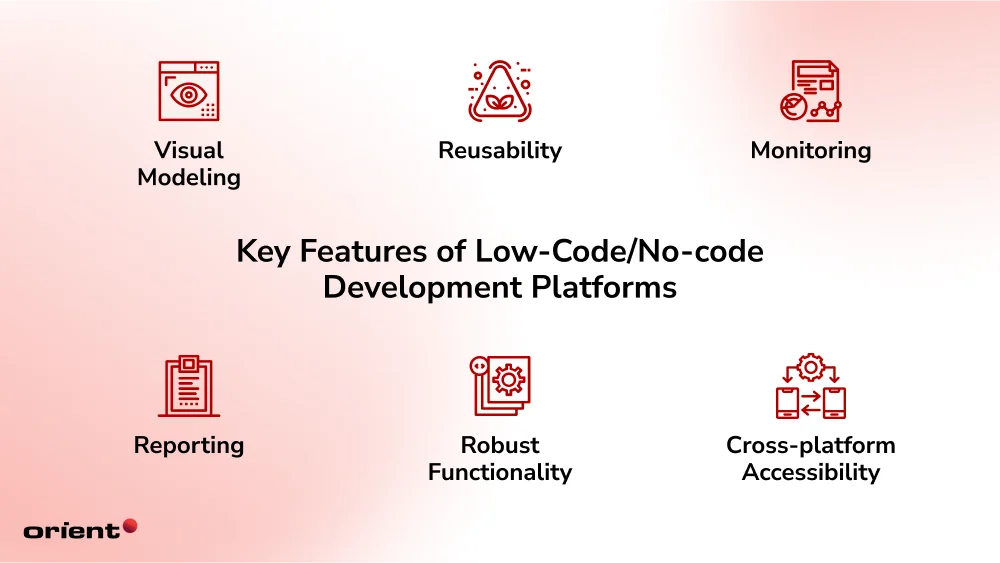
Some may have concerns that low-code and no-code platforms used in the development process may result in lower quality, limited customization options, or security issues. Fortunately, as these platforms continue to evolve and improve, we can be positive that these concerns will be addressed.
Emphasis on Cybersecurity and Data Protection
Data security has become a critical concern for organizations with the increasing digitization of businesses and the growing use of cloud-based services. Software development outsourcing can bring security risks, including data breaches, intellectual property theft, and compliance violations. As such, companies need to prioritize security and data protection when outsourcing software development projects.
One of the top software outsourcing trends we continue to see in 2025 is an increased focus on data security and protection in outsourcing development. This will involve companies working closely with their service providers to ensure security measures and protocols are in place to protect sensitive data and intellectual property. Plus, companies will need to ensure that their outsourced partners comply with relevant data protection and privacy laws, such as the GDPR, CCPA, and HIPAA.

According to IBM, the average cost of a security breach is $4.24 million. To minimize the risks associated with software outsourcing services, companies will need to adopt a risk management approach that includes identifying and assessing potential security risks, implementing appropriate security measures, and monitoring and evaluating the effectiveness of those measures. This will require close collaboration between companies and their outsourced partners and ongoing communication and transparency to ensure everyone is on the same page regarding security and data protection.
Hybrid Models: Multiple Engagement Models and Vendors
Software outsourcing models have been altering over time from a simple staff augmentation model to turnkey project delivery model towards more flexible models such as BOT (Build-Operate-Transfer), Co-Sourcing, Managed Services and many others. This is driven by the constantly evolving demands and rising expectations that business owners nurture for outsourcing, which continue to expand year after year.

In the near future or even now, many organizations are leaning toward hybrid outsourcing. It is a configurable outsourcing model which allows them to leverage the advantages of multiple outsourcing models or services at the same time to complement each other and strike the balance between cost, quality, and risk.
You can combine different outsourcing models and services from different vendors to create the best fit for your needs. In this flexible model, you can tap into the top talent for high-stakes tasks while outsourcing other functions to cost-effective regions if you want. Especially when businesses are constantly seeking customizable and cost-efficient solutions, hybrid models are trusted as the way of the future.
More than that, business owners have a tendency to hire independent contractors or freelancers for specific projects or tasks on a more flexible basis. Perhaps businesses are figuring out their own ways to get over vendor lock-in and increase flexibility in their outsourcing initiatives. Either way, it’s a trend that is likely to continue in the future.
Importance of User Experience: Meeting Customer Needs through Outsourcing – Opt for Progressive Web Apps (PWAs)
As the software industry becomes increasingly competitive, companies recognize the importance of delivering exceptional user experiences to differentiate themselves from competitors. User experience encompasses all aspects of how users interact with software, from the initial design to the final product. Creating a positive user experience can increase engagement and customer loyalty and improve business outcomes. Outsourcing software development focusing on user experience has become a key trend in the industry, now as well as in the future.
One way to optimize user experience is through the use of progressive web apps (PWAs). PWAs bring together the best of both web and mobile experiences to deliver functionality, fast load times, and lower data usage.

That’s why outsourcing the development of PWAs is poised to take the central stage in the upcoming time. In 2025, the adoption of progressive web apps is expected to rise, particularly in industries where user experience always comes first. For example, e-commerce or hospitality. The PWA market size was valued at $2.2 billion in 2024, and it is forecasted to grow up to $2.8 billion in 2025. At a remarkable CAGR of 31.4%, the number may surpass $74.1 billion by 2027. (Source: Research Nester)
Remote Working Drives the Demand for Cloud-based Software Outsourcing
Remote working is nothing new, but it has become ubiquitously popular after the global pandemic (COVID-19). One Gartner Survey in 2020 indicated that 82% of business leaders planned to promote remote working within their workplaces. The rise of the “gig economy” - wherein businesses can hire independent contractors or freelancers for particular projects or tasks on a flexible basis – is also a driver behind the growth and public awareness of remote working.
In the remote-first world where we are heading, a large portion of organizations have fully adopted remote work while others take it slow with the hybrid arrangement – a blend of remote and in-office work.
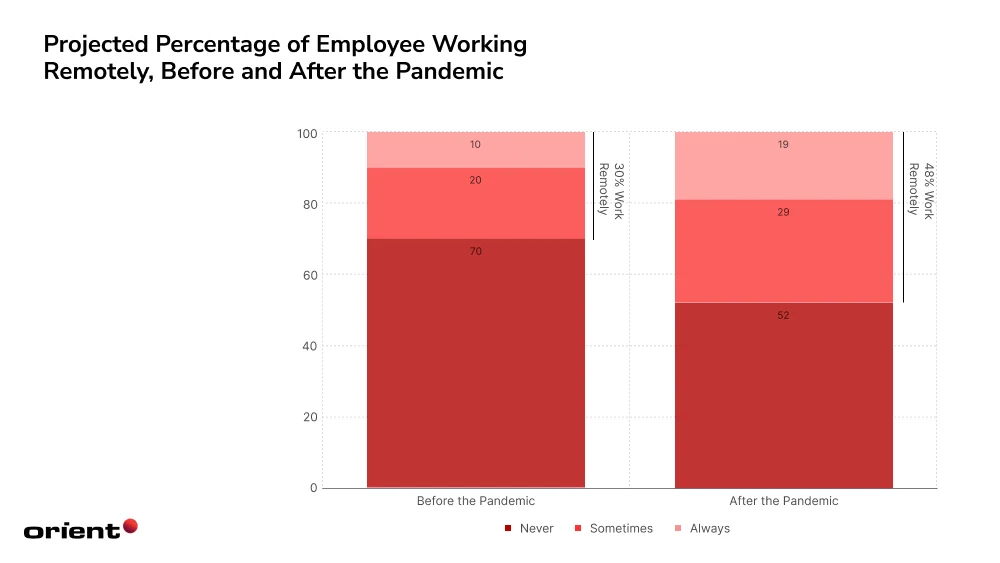
Either way, the shift toward remote working models may soon trigger a surge in demand for cloud-based software outsourcing as most remote-friendly companies need to adopt cloud services and platforms to facilitate an environment for their employees to work from anywhere. According to Market Research Source, the market size of cloud-based software development outsourcing is expected to grow from $34.0 billion in 2022 to $141.2 billion by 2027.
Emergence of New Outsourcing Destinations
Traditionally, India, China, and Eastern Europe have been popular outsourcing destinations due to their large pool of skilled software engineers and cost-effective solutions. However, several new destinations have emerged as fine alternatives in the past few years and in the future.
Countries with younger population and lower labor costs are on the radar. For example, Vietnam and the Philippines. Latin America is one region with great potential for software outsourcing as well. At present, Vietnam is being well recognized as the best new alternative hub for software development and IT outsourcing services, and this country will keep up its momentum in 2025 and beyond.

In addition to lower prices for specialized skills or talent, many of these countries offer favorable government policies and incentives for foreign investors. The advantages make them attractive destinations for business owners around the world to outsource software development needs to.
The emergence of new outsourcing destinations has something to do with the rise of remote working, nearshore and onshore outsourcing, and the increasing availability of digital communication tools. This has made it easier for companies to collaborate with software development teams in different parts of the world. As a result, smaller and lesser-known outsourcing destinations are having more opportunities as business leaders and startup companies seek to diversify their outsourcing portfolios and explore new options.
Orient Software - Your Single Source for Software Development Outsourcing Services in Vietnam
We, Orient Software, are no outsider to the world of software development outsourcing, but true experts. Founded and been in business for almost two decades long, we have grown into an IT powerhouse where you can find all the professional support you need.

Whether you intend to entrust us with the entire project or only delegate one or some specific business processes, we have the expertise and experience to help you. We have consultants who are well-versed in technical and business functionality to provide you with the best-suited solutions. We can also provide you with valuable insights into trends, best practices, and strategies to optimize your outsourcing experience and stay ahead of the curve.
Our service offerings include custom software development (web application development and mobile apps), QA testing, UI/UX design, dedicated teams, staff augmentation, and more. Get in touch for further discussion. We look forward to meeting you soon.




